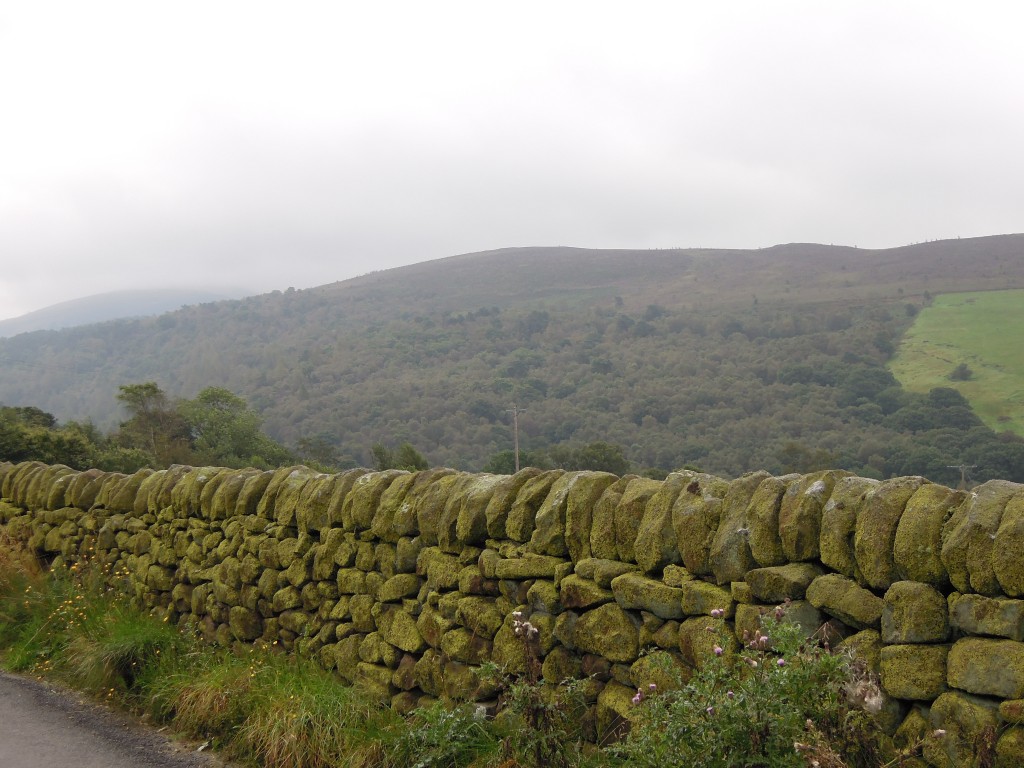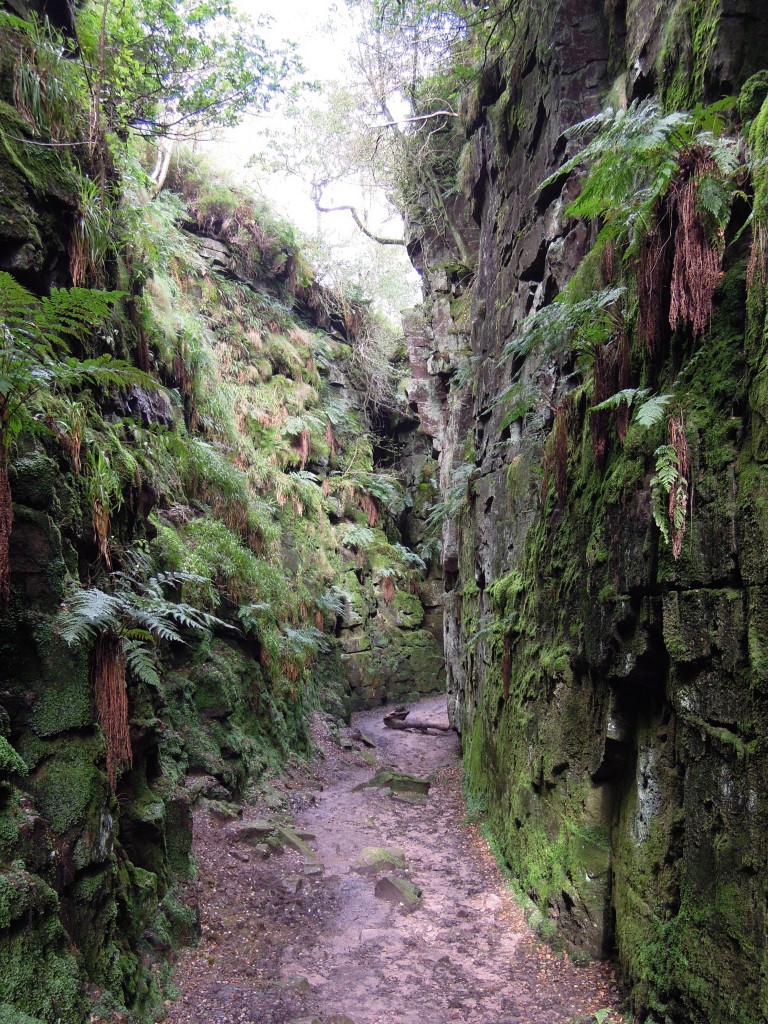The ‘Dark Peak’, the land to the south and east of Macclesfield rising up above the Cheshire plain, is a wild place. We are in England though, and even here in the North, things are only mildly wild. This is no wilderness, we are only 25 miles from Manchester, once the ‘workshop of the world’. The area is criss-crossed with (exciting narrow) roads and dotted with farms, but is not totally domesticated or defined by human control. Some 600 years ago its primary purpose was for hunting, as the place name Wildboarclough reminds us. I recently visited a wild place here which is geologically interesting but also spooky, with echoes of medieval violence.
The primary colour of this land is green. Note how even the stone walls are green, because the sandstone rock is covered with moss. The wooded hillside you see is a dip-slope – the slope follows the upper surface of a layer of durable coarse sandstone. The woods contain a magical secret place, which is where we are headed.
Our destination is best reached via Gradbach. This contains an old silk mill, where in the 19th Century water-power was used to drive machinery to weave silk. Such places (more usually involving cotton weaving) were the nursery of the industrial revolution. Water power was soon replaced by coal-fired steam power and production shifted from rivers in the middle of nowhere into big cities such as Manchester. Though far from rivers, the new buildings full of looms were still called mills. The Gradbach mill is now a Youth Hostel, giving children a taste of the wild.
Once across the river and in the woods, everything seems normal. You walk up some muddy paths and you reach a set of small crags. Carboniferous sandstone, coarse grained and with cross bedding – very typical of the area. Note the green algae staining.
Sitting within these woods, almost hidden amongst the undergrowth is an entrance to another world.
You walk down a little way and you are in a deep dark space like nowhere else I’ve ever been. The air is cool, muffled and moist. Every surface is damp and green. The sky above seems a very long way away, peeking down between two great walls of sandstone, covered in ferns, moss and liverworts. A place that is neither underground or above ground, a chasm not a cave, a rocky place full of plants. This is Ludchurch.
Geologically, this is a large landslip, of unknown age. The bedding planes in the rock, the Roaches Grit, are sloping down hill. A weak layer, probably shale, allows movement sideways and the rock parts along vertical joint planes. A chunk of rock 100s of metres long has slid a few metres downhill, creating a hole in the ground that’s filled with plants and mystery.
What did the medieval inhabitants of the land make of it? Without our modern day paths, the most obvious way to encounter Ludchurch is to ride over the top and fall to your death into it. Even now dead sheep can be found at the bottom. Over the years Ludchurch has gathered many myths and stories and inspired a great work of literature.
Sir Gawain and the Green Knight is a complex story from the late 14th Century. Sir Gawain, of King Arthur’s court, gets involved in a ‘beheading game’ with a mysterious Green Knight (like you do). The climax of the story takes place in a Green Chapel. The story is written in a Cheshire dialect, now extinct but recognisable only a few generations ago. Many scholars have linked the Green Chapel directly to Ludchurch itself. That a local man writing a story of the supernatural would be inspired by Ludchurch makes perfect sense to me.
The Green Knight has been linked to the Green Man, a common carved or painted figure in old English churches. It represents a pagan vegetative deity, a figure who embodies the growth cycle of plants. Such a figure would certainly like Ludchurch, covered with plants as it is. The fact that it is made of Carboniferous rocks is appropriate too. This was a time when the air was rich in oxygen, supporting vigorous forests – a golden time for a Green Man. How appropriate then that a block on the base of Ludchurch shows a plant fossil, partly covered in moss and liverworts.
Spooky postscript
I visited Ludchurch during a week’s holiday based in the area. On an earlier day I’d visited the Manifold valley in search of interesting rocks to tell you about (watch this space).
On this other trip I photographed a crag of massive reef limestone. When later researching the link between the Green Chapel and Ludchurch, I found a website that decided that a limestone cave at Wetton Mill was a better fit for the Green Chapel. The name sounded familiar – I clicked on their photo and found a picture of the same crag from the same spot!
This is purely a coincidence of course. The nature of things is that wildly improbable coincidences happen all the time. It still made the hair on the back of my neck stand up.
A note on nomenclature. Ludchurch is more popularly known as Lud’s Church, but my father, who holidayed here in the 1940s and has always lived nearby, knows it by the non-possessive version that I’ve used. There are many suggestions as to who Lud was, which means no-one knows, but for sure it is nothing to do with the Luddites. Don’t let anyone tell you otherwise.









Pingback: Ecton – copper, limestone and folds | Metageologist
The Gawain poet rather wonderfully calls the Green Chapel “no-but an old cave” the point being that when Gawain comes to it it’s nothing as spectacular or spooky as we and Gawain have been led to believe–rather a let-down in fact. Lud’s Church is far too mysterious and impressive a site to fit this bill and is not, moreover, a cave.